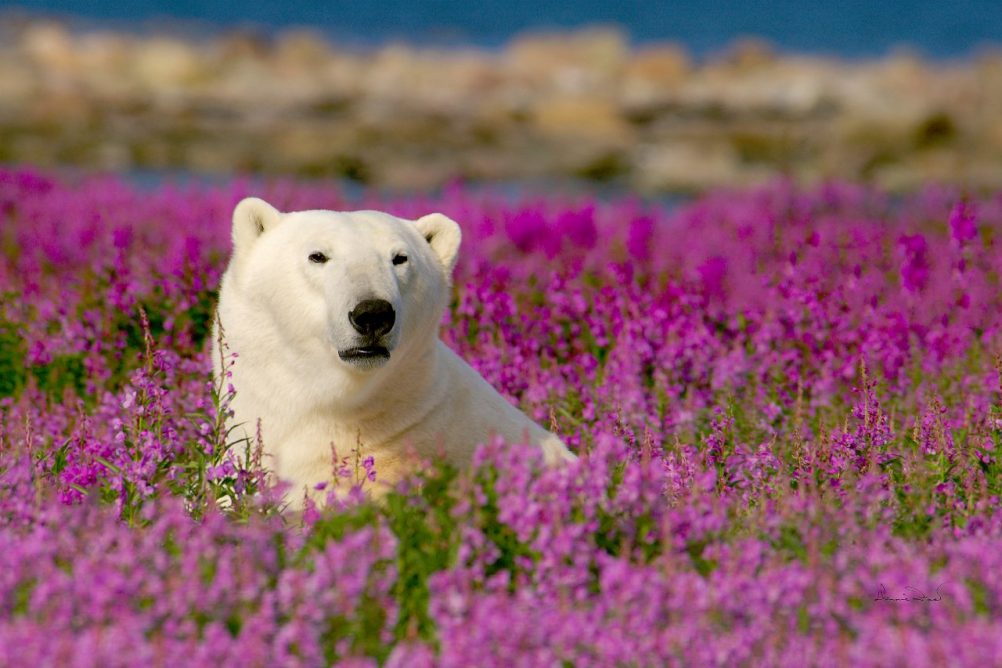Walking with polar bears
Close-up encounters at the top of the world
Words by Ute Junker
Photo Dennis Fast for Churchill Wild
When you’re hunting polar bear on foot, you need the right equipment. Our guide, Terry, carries an impressive array of weapons that can be used to drive off a rampaging bear: rocks, pepper spray, a noisy “bear banger” pistol and, most seriously, a 12 gauge stun gun. However, Terry tells us, the only reason a polar bear would attack is if one of us does something stupid.
“And since I have to fill in more paperwork if I shoot a bear, I’ll probably shoot you instead,” he says. We stand warned.
Some would say our whole expedition qualifies as “something stupid”. Our base, Seal River Lodge, is located on the western coast of Hudson Bay, part of Canada’s great northern wilderness. Mile after mile of sub-Arctic tundra surrounded by rippling waters: it’s the sort of territory that polar bears love. The second we step beyond the electric fence that surrounds our lodge, we slide several rungs down the food chain.
Yet here we are, walking out of the compound, locking the gate behind us, heading into the tall grass that fringes the electric fence. Terry has pointed out a polar bear in the distance, lounging on the shingle by the sea, which we’re going to try to get close to. We walk single file, Terry in the lead, me directly behind. “I wonder where that other bear I saw earlier got to,” Terry muses – then stops. That bear is directly in front of us, nosing through the grass.
The bear, it must be said is not threatening us. The bear is not even looking at us. In fact, the bear is completely unaware of our presence. And that’s a problem. Among the many things you don’t want to do around polar bears, as outlined by Terry in his introductory lecture, one of the most important is that you don’t want to startle them. Given that we’re not only behind the bear, but also upwind of it, we have to find some way of making our presence known without startling the bear.
So Terry employs weapon number one in the Defending Yourself Against Polar Bears arsenal. He talks to it.
“Hello, pretty girl,” he says.
This is not as nutty as it sounds. Talking to polar bears is a useful defence mechanism, as polar bears are not used to the human voice. More often than not, if you talk to a bear, it will wander away. That’s what we’re told, anyway. And sure enough, as Terry keeps telling the bear how pretty she is, she slowly moves out of range.
Chalk up another lesson about polar bears. It’s only my first day at Seal River Lodge, but I’ve already learnt a lot. For a start, I’ve learnt that you don’t need ice to have polar bears. Somehow I’d always thought the two went together like gin and tonic. But it’s the beginning of the northern autumn, and although there’s no ice in sight, there are plenty of bears around – prowling through the grass, lying in beds of dry kelp, munching on berries.
Yes, munching on berries – something else I didn’t know bears did. But I can assure you they do – not only have we seen them in action, but we’ve also seen numerous piles of polar bear poop, filled with undigested little blue berries.
The most important thing we’ve learned, however, is that it’s possible to get close to a wild polar bear. Really really close – as in 25 metres away. It’s an extraordinary experience – and one that can’t get anywhere else in the world
The nearby outpost of Churchill – about half an hour away by small plane – sells itself as the world’s polar bear capital, and has built an entire industry around polar bears. However, the Churchill tours take place in tall enclosed vehicles, and get close to bears who are scavenging in town. For a chance to experience the true majesty of the polar bear in its natural habitat – and to get close to them on foot – you have to come out to Seal River Lodge.
Seal River Lodge is not a luxury experience. Guests stay in no-frills twin or quad rooms, and the food is simple but plentiful. But the polar bear sightings are superb – with meals served in the octagonal dining room that has picture windows on each side, even breakfast becomes a bear spotting opportunity.
Hudson Bay has an estimated population of around 1,000 polar bears, and early autumn is a great time to see them. We’re past peak feeding season – April through to July – when the bears are out prowling the ice looking for seal pups to snack on. We haven’t yet reached the snow season, when freezing temperatures can interfere with camera equipment, and the aggressive behaviour of males places limits on how close you can get.
At this time of year, polar bears reduce their metabolism and enter a state called walking hibernation. From our perspective, it looks like they’re on holidays – lying in the grass, taking a stroll along the seashore, or snacking on whatever’s available, whether that’s berries or even kelp.
With at least two hikes a day, each of which usually includes several sightings, we quickly get master the basics, particularly how not to scare off a polar bear. We approach in a zig-zag pattern, to indicate we’re not a threat; we stay close together so that we appear as a smaller, less intimidating entity.
Occasionally, however, a bit of scaring off is exactly what’s required. One afternoon, we’re slowly working our way towards a polar bear that’s lying amid some rocks, about 100 metres away, when the bear suddenly decided to take an interest. Sitting up to check us out, she’s clearly intrigued: she raises her rather hefty bulk and starts walking towards us, using the same non-threatening, zig-zag approach we’ve been applying.
Breathless with excitement, we stand still as she draws closer. She’s 60 metres away, 50 metres, 40. When she’s about 30 metres away, our guide advises us to spread out – it’s time to look intimidating, for a change. Terry has already started talking to her, trying to convince her to change direction. But she’s definitely intrigued. She heads closer again, but some more rocks finally convince her we really don’t want to get any friendlier.
When she’s 25 metres away, it’s time to take action. Terry throws some rocks in her direction to drive her off, ensuring the rocks land near her, rather than hitting her. Understanding clearly that she’s not wanted, the bear gives us a reproachful look and turns around – before deciding to give us a second chance.
She heads closer again, but some more rocks finally convince her we really don’t want to get any friendlier.
Bears also frequently mooch around the lodge at night, presumably drawn by the lights or, perhaps, the dinnertime aromas. The night we enjoy grilled trout, no fewer than three bears pace the fence, trying to find a way to get closer. Between watching the bears and the northern lights displays, our nights are almost as busy as our days.
By the second day of our week-long stay, we’re becoming accustomed to the sight of polar bears, and we start paying attention to our surroundings. At first glance, the sub-arctic tundra is a harsh, cheerless landscape. Vegetation is low and scrubby, punctuated with splashes of colour courtesy of the fireweeds – well past their purple summer splendour, their fading red and white blooms still enliven the landscape.
As we start looking closer, however, we discover there’s an entire miniature eco-system at ground level. What appear to be scrubby bushes are actually dwarf willows and beeches, each of which has struggled for around 100 years to reach its present height. Incredibly, there’s an entire old-growth forest here, reaching no further than our knees.
The springy ground under our feet turns out to be carpeted with a range of plants. In addition to green peat and orange and yellow lichens, there’s an array of miniature berries, from blue crow berries to vibrant red crow berries. Tiny purple buds turn out to be dwarf rhododendron, while the dwarf Labrador tea quickly becomes a favourite. When crushed, the small spiky leaves release an amazing scent somewhere between lavender and menthol, enveloping us in aromatic scent as we stride across the flatlands.
Polar bears aren’t the only animals to make their home in this complex landscape. The endearing sik-sik, a large squirrel, darts from hummock to hummock with incredible speed. We also spy Arctic hares and even Arctic foxes, lanky creatures that seem both terrified of and fascinated by us.
Large flocks of migrating geese, numbering in the hundreds, drift southwards on the wind. Occasionally we’re woken by a plaintive call. Looking out the window, we see a magnificent sight: a flock of geese, borne by a strong north wind, silhouetted against fly a blindingly white full moon.



